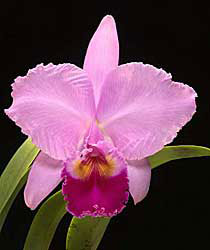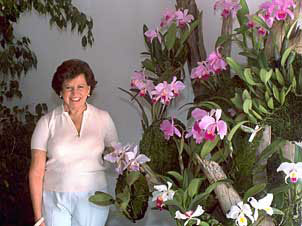Human Flower Project
Friday, October 27, 2006
An Eye for an “i”
The orchid experts draw swords—nearly—over a vowel. Many thanks to Greg Allikas for this glimpse into the politics of botanical names.
 Cattleya trianaei
Cattleya trianaei
Photo: Greg Allikas
By .(JavaScript must be enabled to view this email address)
The national flower of Colombia is a beautiful orchid by the name of Cattleya trianae, or as this report contends, Cattleya trianaei. The species was discovered as early as 1842, when Jean Linden came across it in Colombia. But it was another decade before these plants flowered in Europe. By 1855, Linden was offering them for sale in his catalog as Cattleya trianae, dedicated to José M. Triana, author of Flora Colombiana, and the man who sent the first substantial quantities of the orchid to Europe.
H. G. Reichenbach described the orchid in 1860, spelling it Cattleya trianaei, to reflect the male gender of José Triana. But for the next hundred years nearly everyone, including Linden, Sanders, Veitch and the RHS International Orchid Registry, dropped the “i” and spelled the species “trianae,” as it’ s pronounced tri-AN-ee.
And so it was spelled for many years until Mrs. L. Sherman Adams of Wellesley, Massachusetts, began lobbying to restore the correct spelling of this national flower of Colombia. The movement made temporary progress. As Carl Withner reports in Volume 1 of his The Cattleyas and their Relatives, “As of the 1961-70 Addendum to Sander’s List of Orchid Hybrids published by the RHS, the name is to be spelled with an “i” at the end…all is secure once again!”
Of course, as with most situations like this, both names persisted throughout the 20th century, a confused coexistence where many people (self included), unsure which was correct, just used the shorter version because it looked easier to pronounce.
A decade or so ago, however, a team of scientists at Kew began DNA research on orchids. The results were not only novel, they have shaken the foundations of orchid nomenclature. Kew began publishing these new names as the “Monocot Checklist.”
A few years ago the American Orchid Society settled upon using Kew’s checklist as its own official source of orchid names to avoid further confusion; Kew had decided to keep the shorter, feminized spelling: Cattleya trianae.
 Adelaida de Bohmer and her collection of Cattleya trianaei
Adelaida de Bohmer and her collection of Cattleya trianaei
Cali, Colombia (1999)
Photo: Greg Allikas
The September 2006 issue of the AOS magazine, featuring an article about 20th century orchid growers H. Patterson & Sons, mentions this Colombian Cattleya throughout. Because the AOS has adopted the Monocot Checklist as its official source of orchid names, the editor dutifully removed the “i” from the end of every instance of C. trianaei in the article.
Its author, Jeff Bradley, is a dedicated grower of cattleyas who specializes in collecting old and rare cultivars. A thorough researcher , Bradley demands accuracy. He was astounded that the magazine editor had changed the spelling of C. trianaei to the incorrect, C. trianae, but understood the reason. He then wrote Mark Chase at Kew, one of the researchers involved with the Monocot Checklist, and was essentially told that Kew had no intention of restoring the correct spelling. In a personal communication, Jeff told me that he has rallied the troops, including Carl Withner in Seattle, Ernest Hetherington in California and A.A. Chadwick in Delaware. Jeff has begun a petition to publish the correct spelling in Taxon, and as he said, “Once done, that will be the end of it.”
Meanwhile, the AOS has formed an ad hoc committee to discuss future protocol for verifying correct plant names at their Members Meetings in St. Louis next month. The venue for these meetings is somewhat ironic. Many in the organization feel that instead of the Kew list, we should be using a domestic product, Missouri Botanical Garden’s VAST nomenclatural database. We will wait to see if new policy is adopted, if not for many exceptional orchids, at least for Colombia’s Cattleya trianaei.




